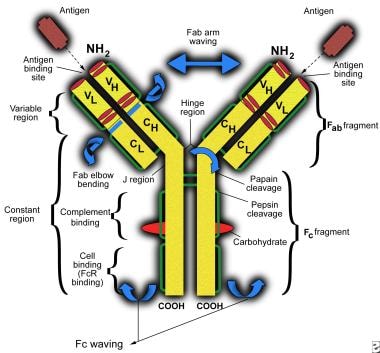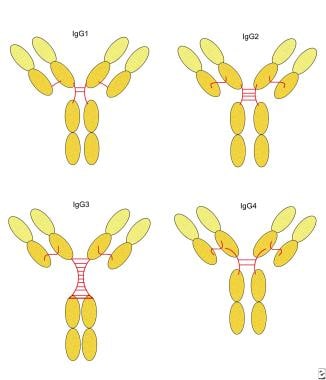Background
Immunodeficiency diseases are commonly classified into disorders that affect one or more of the 4 major limbs of the immune system. These limbs are (1) B cells, ie, humoral immunity; (2) T cells, ie, cell-mediated immunity; (3) phagocytes; and (4) complement.
B-cell immunity is mediated by the immunoglobulins and is commonly referred to as humoral immunity. Humoral immunity is differentiated from T-cell immunity, which is commonly referred to as cellular immunity, and from phagocytic cell immune function. Immunoglobulins, which are protein molecules that contain antibody activity, are produced by the terminal cells of B-cell differentiation known as plasma cells. Immunoglobulins have important roles in humoral immunity, and they consist of 5 major classes or isotypes: immunoglobulin G (IgG), immunoglobulin A (IgA), immunoglobulin M (IgM), immunoglobulin D (IgD), and immunoglobulin E (IgE). The most abundant class of immunoglobulins in the blood is IgG (73%), which has a molecular weight of 150 kd. IgG is present in plasma and external secretions and is expressed on the B-cell membrane.
Immunoglobulin G deficiency. Schematic representation of an immunoglobulin G molecule. CH indicates constant region of heavy chain; CL, constant region of light chain; VH, variable region of heavy chain; and VL, variable region of light chain.
IgG is further subdivided into 4 subclasses: IgG1, IgG2, IgG3, and IgG4. Fortunately, for ease of recall, the serum concentrations of the subclasses directly correlate with their numerical nomenclature, such that IgG1 is found in greater concentrations than IgG2, and so forth.
Immunoglobulin G deficiency. Human immunoglobulin G subclasses.
In 1952, Bruton described classic X-linked agammaglobulinemia due to B-cell deficiency in an 8-year-old boy. The child presented with frequent pyogenic infections, repeated episodes of sepsis with the same serotypes of pneumococcus, and multiple episodes of mumps, yet he had no antibodies against these pathogens. Serum protein electrophoresis had just become available, and it revealed that the g fraction was missing from the child’s blood. Subsequently, patients were described who had detectable lymphoid tissue and B-cells but had decreased IgG levels and/or lacked specific antibodies. These conditions are now recognized as fitting the categories of hyper-IgM syndromes and common variable immunodeficiency (CVID). A new subset of the latter was recently characterized by reduced C1 esterase inhibitor levels.
In the early 1960s, following the discovery of the IgG subclasses, certain associations were also recognized between individual subclass deficiencies, decreased ability to respond to certain types of antigens (ie, bacterial polysaccharides), and recurrent infection. IgG deficiencies may occur as isolated deficiencies (eg, selective IgG deficiency) or in association with deficiencies of other immunoglobulin types. Moreover, even if the total IgG concentration is normal, deficiencies of one or more individual IgG subclasses, significant decreases in specific IgG antibodies, or both may be observed.
Ig G deficiency in children with recurrent respiratory infections with and without history of allergy was evaluated.
A variable IgG deficiency was documented in less than one-third of the subjects, but that provided no asistance in the differential diagnostics of the allergic background of these children.
For information on deficiencies of other immunoglobulin types, see the Medscape Reference articles IgA Deficiency, IgD Deficiency, and IgM Deficiency.


